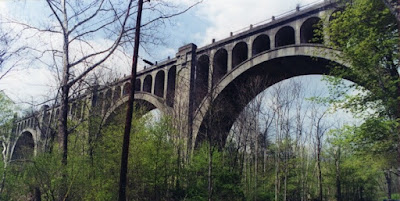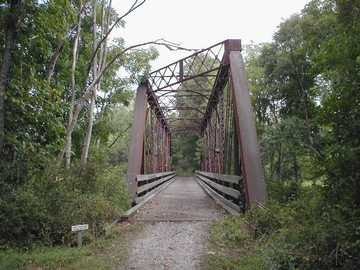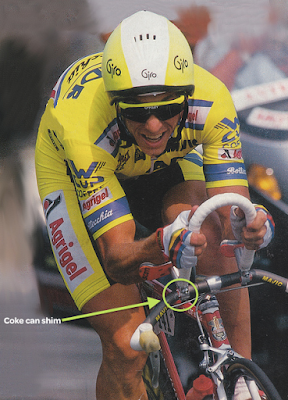Last Wednesday I took a drive near the
Delaware Water Gap to ride a loop that would cover parts of the Paulinskill
Valley and Sussex Branch Trails in North Jersey. These rural trails connect
many small communities along their respective routes, and I certainly was never
far from some evidence of civilization, but the manner in which these paths
beautifully weave along secluded waterways and through thick forests really
make you feel that you are out in the middle of nowhere!
The Paulinskill Valley Trail is on an
abandoned branch of the New York, Susquehanna & Western, a route of particular
interesting to me, as every month I operate on my friend Steve’s model railroad layout, which
features the NYS&W, or “Susie-Q”, as it is nicknamed. I say “operate”
because we use copies of old timetables and switchlists to deliver imaginary
passengers and freight to stations and factories to locations around his
layout. Yes, it might sound a bit geeky to some of you, but the experience is
more about interacting with friends who share a common interest, and it’s far
more appealing than just watching trains go around in circles.
The hobby also allows some of us put our
artistic abilities to use, as we create scenery and structures that look as
close to the real thing as possible. To show my appreciation for letting me
join his group, I built this Pompton Lakes station for Steve’s railroad:
The Sussex Branch Trail was a section of the
Delaware Lackawanna & Western, which is one of my personal favorite
railroads, and in the past I have modeled portions of it on my home layout
(second photo above). Although on this trip I would be riding just part of the Sussex Branch during the return segment of my loop, I rode its entire 18-mile length a few years ago, from Waterloo to Branchville. I remember that trip
well for two reasons: 1. Along the route is a string of small lakes covered with pond lilies, and I was riding in the early spring when their
flowers were in bloom, making much of the ride smell incredible. 2. On the
return leg my rear derailleur blew apart, leaving me to ride single-speed for a
few miles.

The NYS&W and DL&W were big players
in the transport of anthracite coal from the mountains of Pennsylvania to ports
around New York City, but these specific branches hauled agricultural goods,
milk and iron ore from the area and had regular passenger service. You can read
more about the railroad history of these trails by clicking on the logos above.
I started my journey by parking under the
enormous Paulinskill Viaduct (photo below), named after the creek it crosses,
and headed east. There are conflicting stories as to the origin of the word Paulinskill – that is, at least the
first part of the word, because kill
is Dutch for stream or river. I’m very familiar with this etymology, since I
live in the valley formed by the Schuylkill River, which would really be a
pleonasm – the use of more words than are necessary to make a meaning clear, as
in “tuna fish” or “safe haven”. Deriving from the Dutch word schuylen (now spelled schuilen) for “hidden”, it seems folks
in our area are incorrectly saying, “Hidden River River”.
There was about a mile or so of the trail
near Stillwater over which someone had spread a thick layer of fine cinder. As
this is a shared-use trail, I’m assuming the culprits may have been an
equestrian organization, because it definitely wasn’t a surface conducive to
cycling. The depth of the material made riding sluggish and as the cinder has
settled, the path has become terribly bumpy. I can imagine that an extended
ride over this type of “paving” would have caused major fatigue in my arms, but
luckily the abuse came to an end! I was happy to discover that my return route
avoided this section completely.
I briefly considered using a more
road-worthy tire on my ‘cross bike, as about 15 miles of the nearly 50 total
were going to be on pavement, but I’m glad I decided to go with the more knobby
rubber. Because this was a low area near a stream with plenty of tree cover
keeping the sun from drying out the surface, there were some mushy parts of the
trail that were more easily navigated with a wider tread.
As this is a less-traveled path than some of
the trails in my home area, there were plenty of small branches that hadn’t
been cleared. These weren’t anything impassable, but just a few weeks ago while
riding the Raritan Canal Towpath, a branch I had ridden over kicked up and took
a chunk out of my right shin. The fresh pink scar reminded me to be on the
lookout - not that I was going to be a “shin model” or anything, with all
evidence of slashes and lazy stickwork the neighborhood kids have inflicted on my
legs during neighborhood street hockey games, but does anyone really want to bleed?
The ride was very pleasant with the thick
tree cover keeping the sun off of my back, and there were a few railroad
remnants along the way to catch my eye. I crossed several girder bridges and a
large through-truss span that were NYS&W leftovers, as well as a couple
mile markers and even an old signal mast just west of Stillwater.
Determined just to “enjoy the ride” when I’m
on my trail bike, I hadn’t installed a computer on it. The one disadvantage to
this is that I couldn’t get a good grasp on how far I had to go to the
connection with the Sussex Branch Trail. As I rode past a trailhead, I saw a
gentleman unloading his bike and quickly asked he knew if I was nearing the intersection
of the two trails, and he replied that he was just checking a map on his phone.
He confirmed that I had just a short distance to go and pointed out Warbasse
Junction Road, with which I was familiar, since it runs parallel to the Sussex
Branch Trail. I loved that he referred to it as “Wasabi, something-or-other” Road!
Sure enough, I shortly reached the junction of the two trails, nicely marked by wooden signs (photo above), and made the righthand turn to head south on the Sussex Trail. This was another fast section of hard-packed singletrack, eventually reaching the streets just outside of Newton. I quickly covered the four miles to my connection at Stickles Pond Road to take on the non-trail portion of my planned route.
I have mentioned in the past how hard it is to navigate in some areas of New Jersey, as main highways are infrequently indicated on corner signs - most often, it's just the secondary streets. In this section of the state, some intersections were marked only with signs pointing out the direction of local towns. That can’t be particularly helpful to someone who has never heard of Frelinghuysen, Johnsonburg or Allamuchy!
I have mentioned in the past how hard it is to navigate in some areas of New Jersey, as main highways are infrequently indicated on corner signs - most often, it's just the secondary streets. In this section of the state, some intersections were marked only with signs pointing out the direction of local towns. That can’t be particularly helpful to someone who has never heard of Frelinghuysen, Johnsonburg or Allamuchy!
I had carefully mapped out my street route, following Dark Moon, Ramsey and Kerrs Corner Roads, in order to avoid
a couple major hills, and knowing those street names was important to follow that plan.
Things went pretty well except for one stop to speak with a passing driver to make sure I had turned onto the intended (but unmarked) road.
The short, steep ridge that I had to get
over in order to get back to the car was a shock to the system after so much
flat riding, but once that was conquered, and after a mad downhill dash on the
other side to rejoin the trail near Blairstown, it was back to cruising speed on a level path
to finish the trip. I will definitely want to do this one again!









